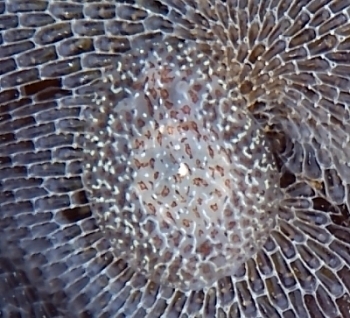
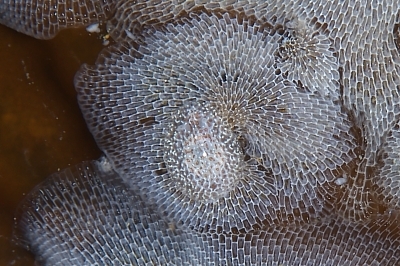
Corambe steinbergae
(Lance, 1962)
Order: NUDIBRANCHIA
Suborder: DORIDINA
Family: Corambidae
DISTRIBUTION
Northeastern Pacific from Alaska to Baja California, Mexico
PHOTO
Locality: Compost (Pfeiffer Point), 6 meters, Monterey, CA, USA, Pacific, 18 August 2007, Macrocystis Kelp Blade. Length: 4 mm. Photographer: Clinton Bauder.
Very similar in general appearance to Corambe pacifica, and found on the same encrusting colonies of the bryozoan Membranipora membranacea, the main distinguishing external feature is the absence of a posterior notch in the mantle skirt of C. steinbergae. The colour pattern consists of reticulate pattern of white lines, arranged to match the skeletal pattern of its bryozoan prey. There are also scattered diffuse red-brown spots. They grow to approximately 15 mm in length and are usually found on kelp, usually Macrocystis, and seagrasses bearing incrustations of Membranipora upon which they feed exclusively. They are often found in competitive coexistence with Corambe pacifica and there have been a considerable number of papers written about their ecology. This species has in recent years been placed in a number of genera [see message]. I am happy to follow the latest revision (Vales & Bouchet, 1998) which places it in Corambe.
-
Behrens, D.W. & Hermosillo, A. (1980). Eastern Pacific Nudibranchs: A guide to the Opisthobranchs from Alaska to Central America. Sea Challengers, Monterey, California.
-
Lance, J. R. (1962) A new Stiliger and a new Corambella (Mollusca: Opisthobranchia) from the northwestern Pacific. The Veliger, 5(1): 33-38, pl. 6.
-
Valdes, Angel, & P. Bouchet. (1998) A blind abyssal Corambidae (Mollusca, Nudibranchia) from the Norwegian Sea, with a reevaluation of the systematics of the family. Sarsia, 83(1): 15-20.
-
Yoshioka, P.M. (1986). Life history patterns of the dorid nudibranchs Doridella steinbergae and Corambe pacifica. Marine Ecology Progress Series, 31: 179-184.
-
Yoshioka, P.M. (1986). Competitive coexistence of the dorid nudibranchs Doridella steinbergae and Corambe pacifica. Marine Ecology Progress Series, 33: 81-88.
Rudman, W.B., 2007 (September 18) Corambe steinbergae (Lance, 1962). [In] Sea Slug Forum. Australian Museum, Sydney. Available from http://www.seaslugforum.net/find/corastei
Related messages
Corambe steinbergae from California
October 5, 2007
From: Clinton Bauder
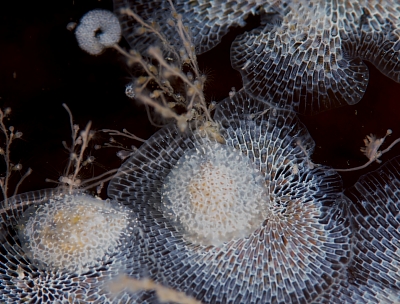
Hi Bill,
Back from another fun day on the Big Sur Coast. A long period swell made macro photography difficult but I did manage some improved images of Corambe steinbergae. These show the rhinophores and what I think are probably Corambe eggs.
Also to preempt the inevitable - yes, I do see the critter to the right of the Corambe s and it does look like a slug of some kind. Sadly I don't have any better images and whatever it is is very small indeed. Certainly I didn't see it when I took the pictures.
Locality: Little Sur Pinnacle, 10 meters, California, USA, Pacific, 28 September 2007, Macrocystis Kelp Blade. Length: 4 mm. Photographer: Clinton Bauder.
Clinton Bauder
gecko1@apple.com
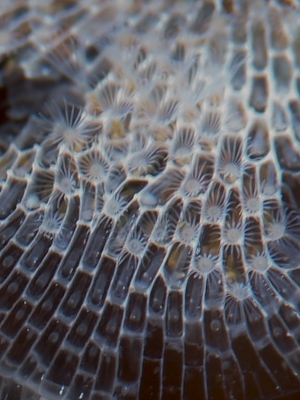
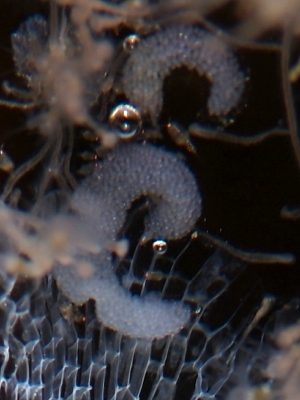
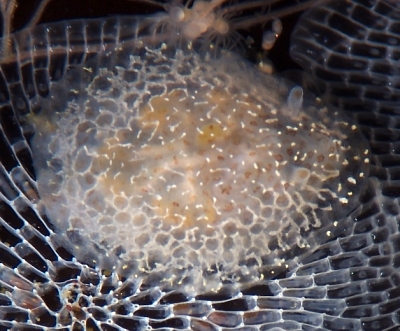
Dear Clinton,
Thanks for these photos and I have followed your hint about not starting a debate about the little juvenile 'something' in your photo. On safer ground, the eggs certainly look like those of Corambe. I have also included a closeup showing the extended bryozoan zooids, each with their circlet of feeding tentacles making them look much like a cnidarian polyp. For those of you who don't know, these bryozoans are the food of Corambe.
Best wishes,
Bill Rudman
Corambe steinbergae from California
September 20, 2007
From: Clinton Bauder
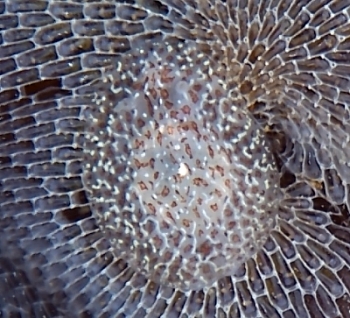
Hi Bill,
I spent some time at the end of a dive off of Pfieffer Point looking for nudibranchs up in the top of the kelp canopy. The Macrocystis kelp was almost completely covered in bryozoans and hydroids and was loaded with Flabellina trilineata and Dendronotus frondosus. After much searching I finally found this little Corambe. Interestingly my camera found several more of them (sadly out of focus) while I was shooting other subjects leading me to believe they were rather abundant. As you can see from this picture, though, they are nearly invisible on their bryozoan prey. Certainly I was having trouble finding them. Based on the lack of a posterior notch I think this one is Corambe steinbergae.
Locality: Compost (Pfeiffer Point), 6 meters, Monterey, CA, USA, Pacific, 18 August 2007, Macrocystis Kelp Blade. Length: 4 mm. Photographer: Clinton Bauder.
Clinton Bauder
gecko1@apple.com
Bauder, C., 2007 (Sep 20) Corambe steinbergae from California. [Message in] Sea Slug Forum. Australian Museum, Sydney. Available from http://www.seaslugforum.net/find/20527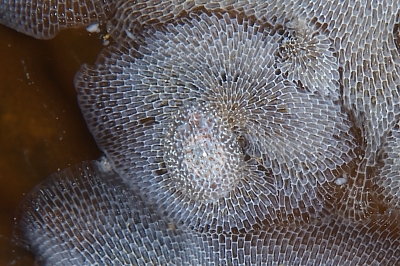
Hi Clinton,
Your identification of this highly cryptic species is perfect. I have often said that because of the food resource of the immense surface area of kelp fronds and the encrusting bryozoans on them, that Corambe has to be the most abundant species along this coast.
This species was named after Joan Steinberg, by her friend James Lance. The genus designation has bounced around several times, with different authors placing the species in Doridella, Suhinia and Paracorambe. Hopefully it will remain in Corambe permanently.
Thanks,
Dave Behrens
